05.07.2025
Non-Alcohol Whisky: Just A Trend Or The Future Of Whisky
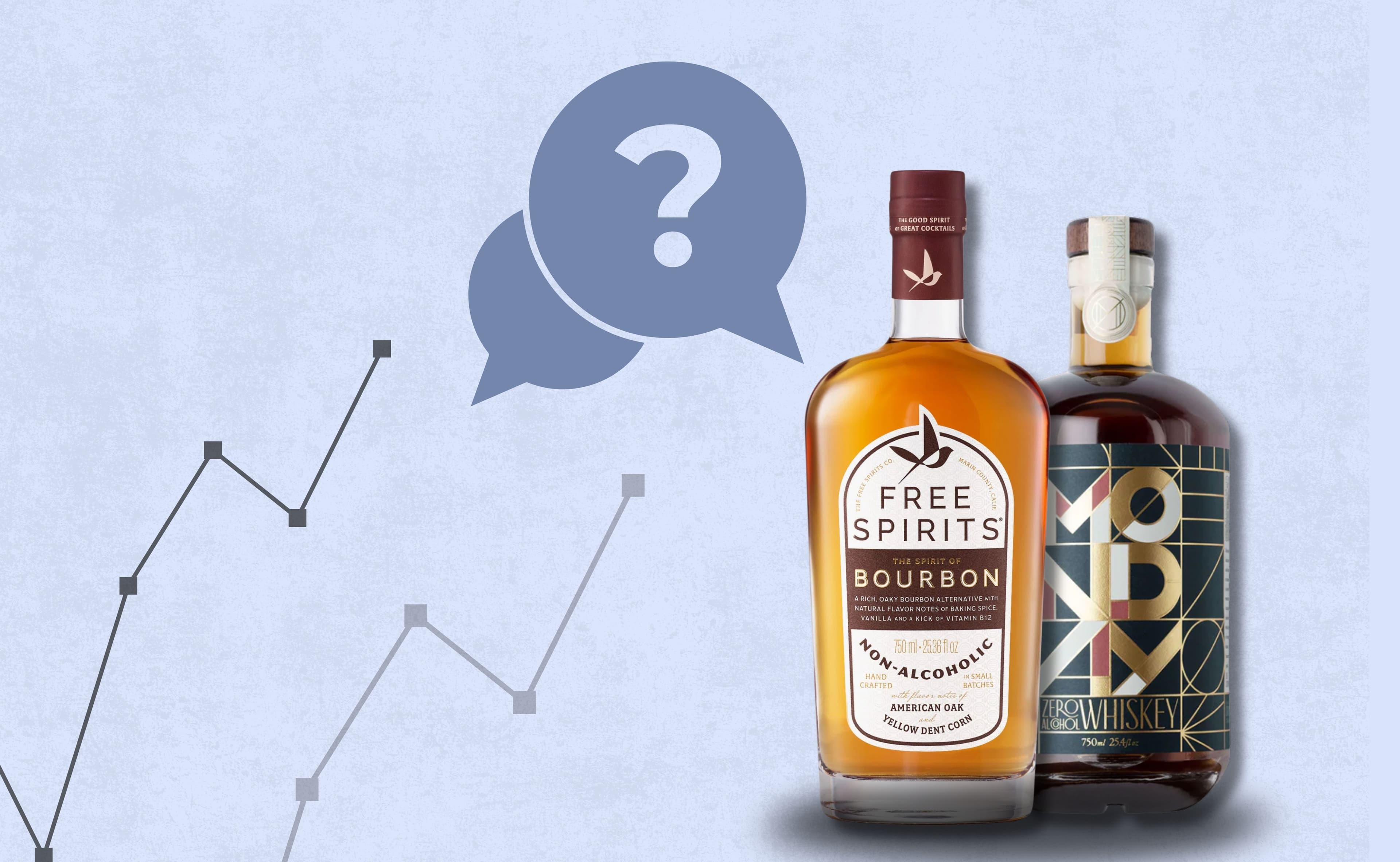
Non-Alcohol Whisky: Just A Trend Or The Future Of Whisky
You might wonder if non-alcohol whisky is just another passing fad or something bigger. Numbers don’t lie—check out the recent market surge:
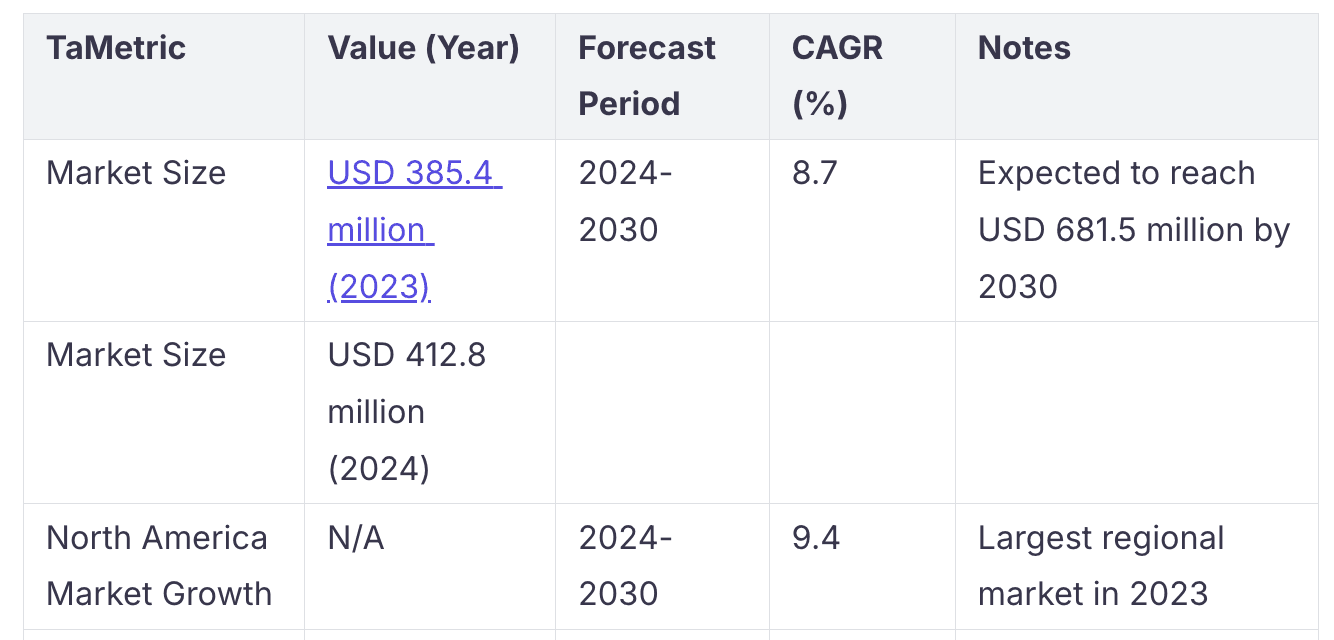
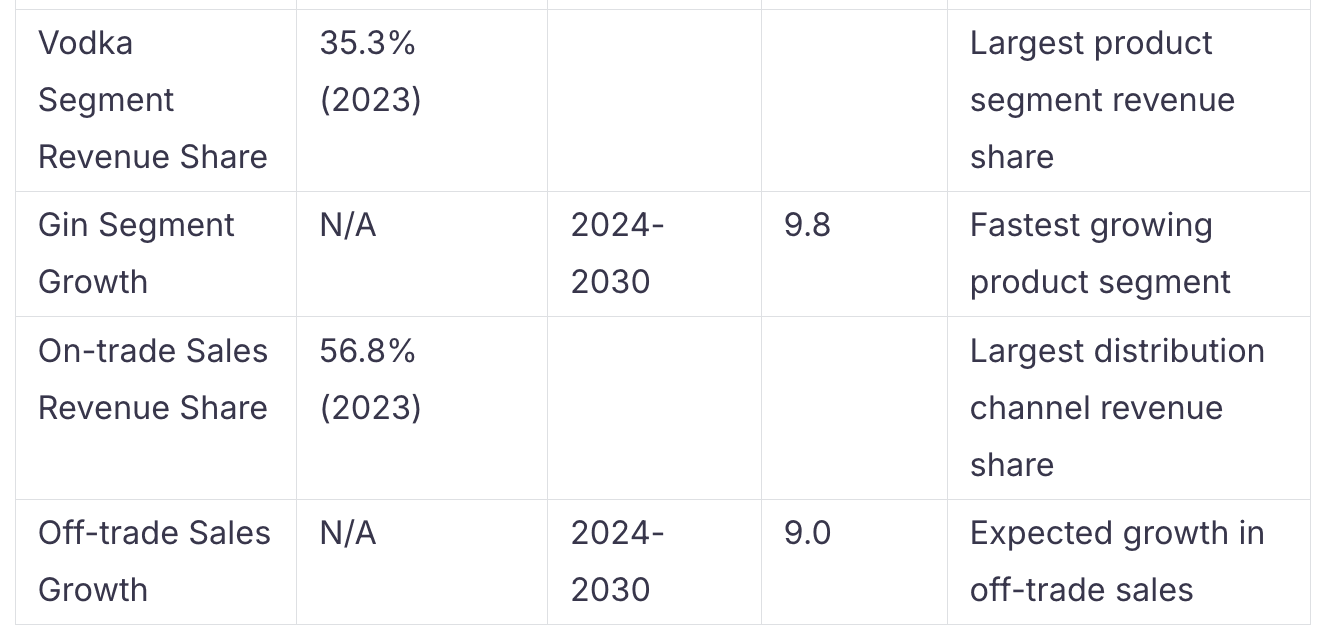
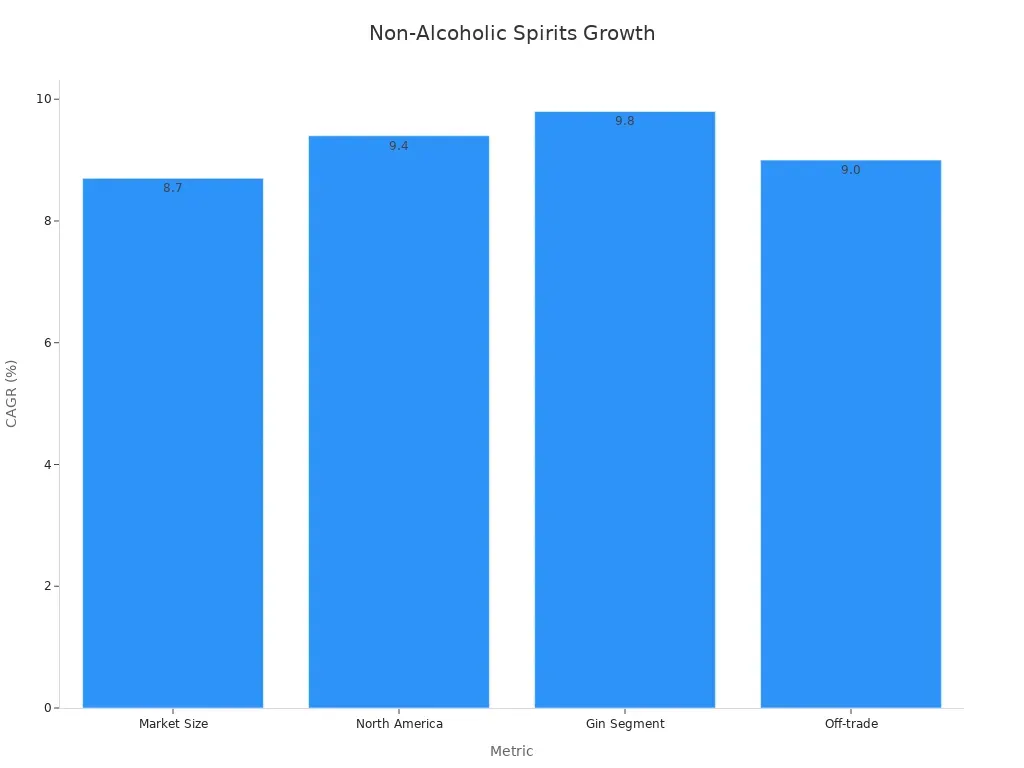
If you love whisky or want healthier choices, this topic matters to you. Shifting lifestyles change what people drink and the non-alcoholic drinks trend can be a way how they enjoy it.
Younger drinkers chase new brands, care about flavor, and value modern packaging.
So, you’re seeing whisky culture evolve right alongside changing habits as a part of a growing trend.
Key Takeaways
-
Non-alcohol whisky offers the taste and experience of whisky with less than 0.5% alcohol, making it a healthier choice without hangovers.
-
The market for no-alcohol spirits is growing fast, driven by younger generations who value flavor, health, and social inclusion.
-
People choose non-alcohol whisky to enjoy social events, stay healthy, avoid alcohol effects, and try new flavors.
-
Non-alcohol whisky captures many classic whisky aromas and flavors but feels lighter and less warming than traditional whisky.
-
The future of whisky includes alcohol-free options becoming mainstream, offering more choices and welcoming new drinkers to whisky culture.
What Is It?
Definition
You might wonder what non-alcohol whisky actually is. It looks like whisky, pours like whisky, and even smells a bit like it. The big difference? It contains less than 0.5% alcohol by volume. You get the familiar flavors and aromas without the buzz. Many brands design these drinks for people who want the whisky experience but prefer to skip the alcohol.
Non-alcohol whisky gives you the taste and ritual of whisky, but you can enjoy it any time—no need to worry about hangovers or breaking your health goals.
How It’s Made
Non-alcohol whisky starts with a process that feels familiar if you know traditional whisky. Here’s how it stands out:
-
Makers use grains and malting, just like regular whisky.
-
They change the fermentation step to avoid making alcohol, so the flavors stay but the alcohol does not.
-
Distillation gets a tweak. The goal is to keep the flavor essence while keeping alcohol below 0.5%.
-
Aging is shorter or uses wood chips, barrel staves, or oak extracts to mimic the taste of aged whisky.
-
Flavor experts add botanicals, extracts, sugars, tannins, and even glycerin. These ingredients help create the warmth, color, and mouthfeel you expect.
-
Some brands use “reverse distillation” or distill botanicals separately, then blend them for a complex flavor.
-
Many producers skip full fermentation or traditional barrel aging. Instead, they use creative methods to capture smoky, woody, and caramel notes.
-
Temperature and pressure controls help extract flavors like vanilla and oak, all without the intoxicating effects.
You get a drink that feels close to whisky, but with a modern twist. The process is all about giving you the taste and experience, minus the alcohol.
Why It Exists
Health Trends
You probably notice more people talking about health these days. Many want to feel good, stay active, and avoid hangovers. That’s where no-alcohol alternatives come in. People like you are choosing drinks that fit a healthier lifestyle. Here’s what’s happening:
-
In the US, 41% of people pick no or low-alcohol drinks mainly for health and wellness.
-
About 32% switch to these drinks to improve their health.
-
Globally, 43% of drinkers enjoy low or no-alcohol drinks sometimes, showing a real shift toward moderation.
You might see friends at bars or restaurants ordering non-alcoholic drinks instead of regular ones. In fact, 46% do this to support their health goals. Most people don’t quit alcohol completely. Instead, they mix in non-alcoholic choices to balance things out.
Tip: Non-alcoholic drinks often include extra health perks, like adaptogens or probiotics, making them even more appealing if you care about wellness.
Studies back this up. When people get free non-alcoholic drinks, they drink less alcohol—by about 11.5 grams per day. This change sticks around for weeks, showing that health-focused habits can last.
Social Shifts
Younger generations are changing the way everyone thinks about drinking. Millennials and Gen Z lead the way. They care about health, but they also want to feel included at parties and social events. Sober curiosity is a big trend. Maybe you’ve heard of Dry January or Sober October? These movements make it cool to skip alcohol, even just for a while.
-
9% of US adults now drink non-alcoholic options at least once a week.
-
Gen Z and Millennials make up most of these “sober curious” drinkers.
-
67% say non-alcoholic drinks help them stay healthy without missing out on fun.
-
74% believe these drinks make social events easier for everyone.
You might notice more cocktails on menus or see friends trying new alcohol-free spirits. Social media, health trends, and even money-saving goals push more people to try these drinks. Brands respond with better flavors and creative packaging, making non-alcoholic spirits more exciting than ever.
Who Drinks It?
Demographics
You might wonder who actually reaches for a glass of non-alcohol whisky. The answer covers a wide range of people, but some groups stand out more than others. Here’s what you’ll notice:
-
Millennials (ages 25-40) often lead the way. They like to try new things and care about health.
-
Generation X (ages 41-55) shows interest, especially those who want to cut back on alcohol but still enjoy the ritual.
-
Baby Boomers (ages 56 and up) sometimes join in, especially if they want to avoid alcohol for health reasons.
-
People with higher incomes tend to buy premium non-alcoholic spirits. They look for quality and unique flavors.
-
Those with college degrees or professional jobs often explore these drinks at tastings or social events.
You see a mix of ages and backgrounds, but most share a focus on wellness and curiosity about new experiences.
Motivations
Why do people choose non-alcohol whisky? The reasons might surprise you. Many want to stay healthy and avoid hangovers. Some just want to enjoy the taste without the effects of alcohol. Others like to feel included at parties, even if they skip the booze.
Here are a few common motivations:
-
You want to keep up with friends but not drink alcohol.
-
You care about your health and want to make better choices.
-
You need to drive home safely after a night out.
-
You enjoy the taste and ritual, but not the buzz.
-
You want to try something new and see what all the hype is about.
Note: Many people mix non-alcoholic options into their routine, not because they quit drinking, but because they want balance.
You might find yourself reaching for a non-alcohol whisky at a work event, a family dinner, or even a quiet night at home. The reasons are personal, but the trend keeps growing as more people look for ways to enjoy life without compromise.
Whisky vs. Non-Alcohol Whisky
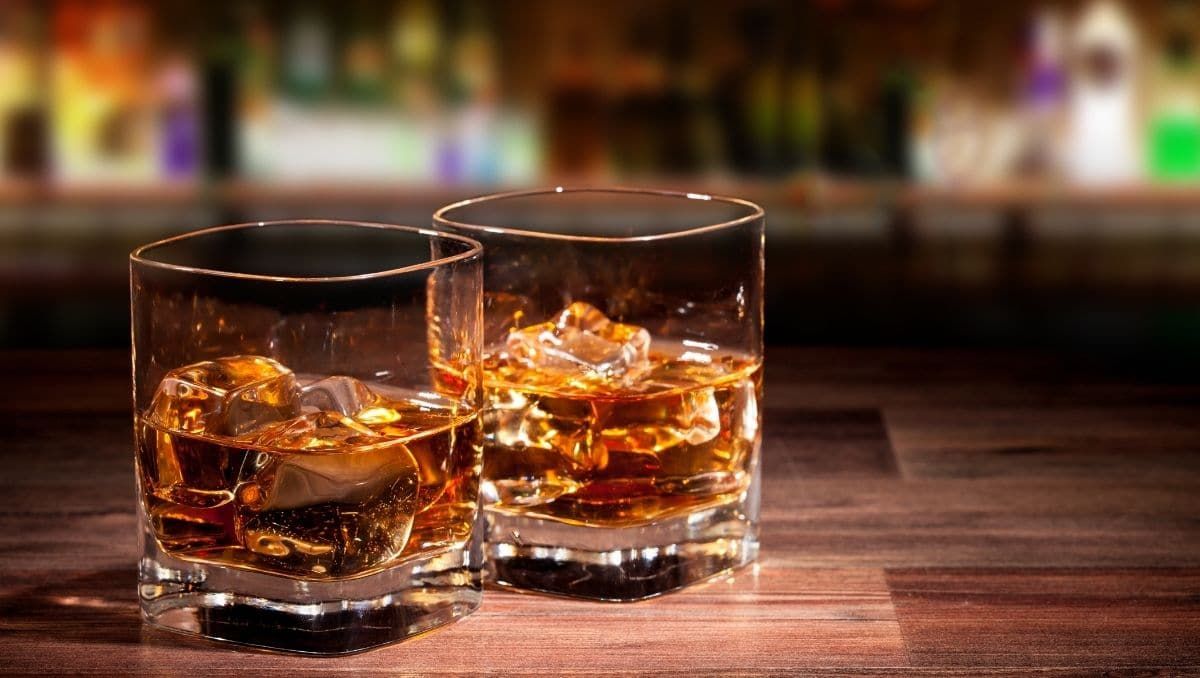
Taste Experience
When you take your first sip, you notice right away that non-alcohol whisky feels different from the real thing. Traditional whisky has a deep, warming sensation that comes from the alcohol. Non-alcohol whisky tries to copy this, but it can’t fully match the same mouthfeel or heat. You might taste caramel, vanilla, or smoky notes, but the finish feels lighter and sometimes a bit sweeter. Some people even say that non-alcoholic alternatives do not have the same premium quality, but thats not really what the difference is about.
Here’s what shapes your taste experience:
-
The order you taste samples matters. If you try non-alcohol whisky first or last in a lineup, you might like it more just because of where it falls.
-
Your past experiences with whisky play a big role. If you remember a favorite bottle, you might compare every new sip to that memory.
-
The people around you can influence your opinion. If your friends or the host rave about a certain bottle, you might find yourself agreeing.
-
Experts and beginners taste whisky differently. If you’re new, you might focus on bold flavors. If you’re experienced, you might notice subtle notes and compare them to classic styles.
Aroma is the star of the show. You pick up hints of vanilla, caramel, fruit, or smoke. These scents come from hundreds of tiny compounds that give each whisky its unique character.
Non-alcohol whisky brands work hard to capture these aromas. They use special blends of botanicals and extracts to mimic the classic flavors. Still, you might find that the taste feels less complex or the finish fades faster. Some people enjoy this lighter profile, especially if they want the ritual without the buzz.
Cultural Impact
Whisky isn’t just a drink—it’s a tradition. You might picture friends gathered around a fire, sharing stories over a glass. The ritual of pouring, sniffing, and sipping brings people together. Non-alcohol whisky steps into this world and offers a new way to join the fun.
Here’s how non-alcohol whisky fits into the culture:
-
You can take part in tastings, toasts, and celebrations without feeling left out.
-
Bars and restaurants now offer non-alcohol whisky in cocktails, so you can enjoy the same flavors in a social setting.
-
Some whisky clubs and events welcome non-alcohol options, making the community more inclusive.
-
You can keep your health goals and still enjoy the ceremony of whisky—no need to skip out on special moments.
Note: The meaning of whisky culture is changing. It’s not just about the alcohol anymore. It’s about flavor, connection, and shared experiences.
You might notice that some traditionalists feel unsure about non-alcohol whisky. They value the history and craftsmanship of classic bottles. But as more people look for balance and new ways to connect, non-alcohol whisky finds its place at the table. You get to choose what matters most—taste, tradition, or togetherness.
Market Growth
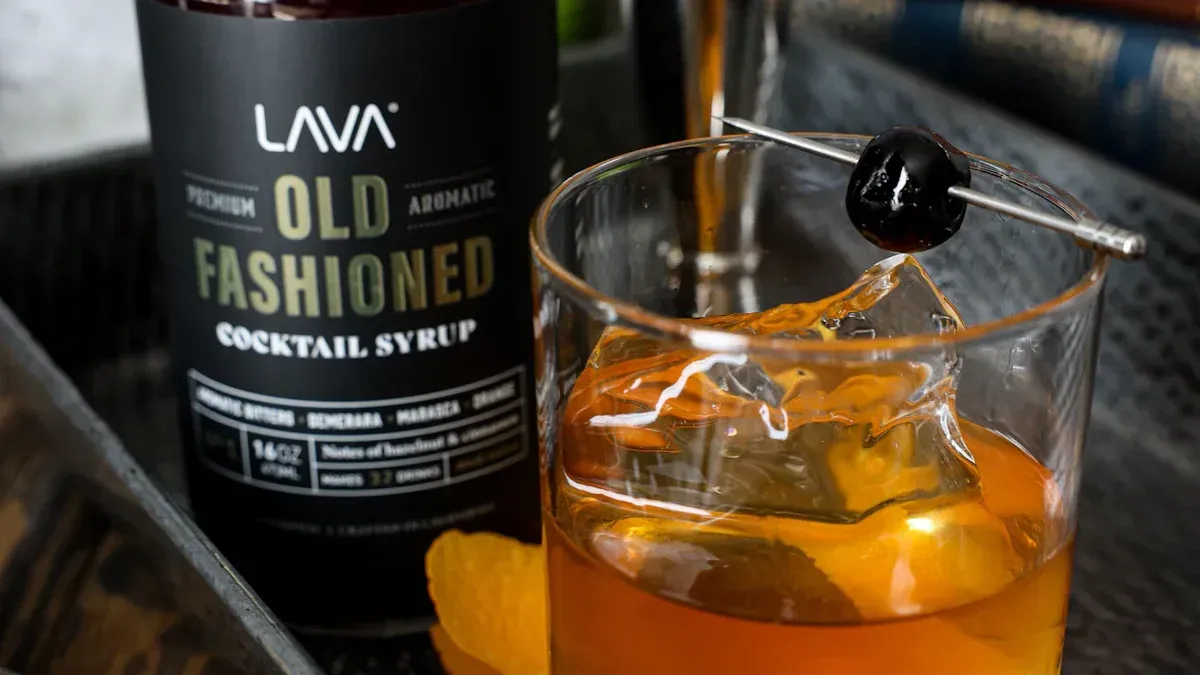
Industry Trends
You see the non-alcoholic spirits market growing fast. Sales and consumption keep rising every year, and more people want healthier choices. In Great Britain, sales and consumption of non-alcoholic drinks have gone up steadily from 2014 to 2023. Experts predict this trend will continue, with no/lo products making up a bigger share of both bar and store sales by 2025. Even people who used to drink a lot now use these products to cut back, with numbers jumping from 24.6% in 2020 to 38.1% in 2023.
Take a look at some key market stats:
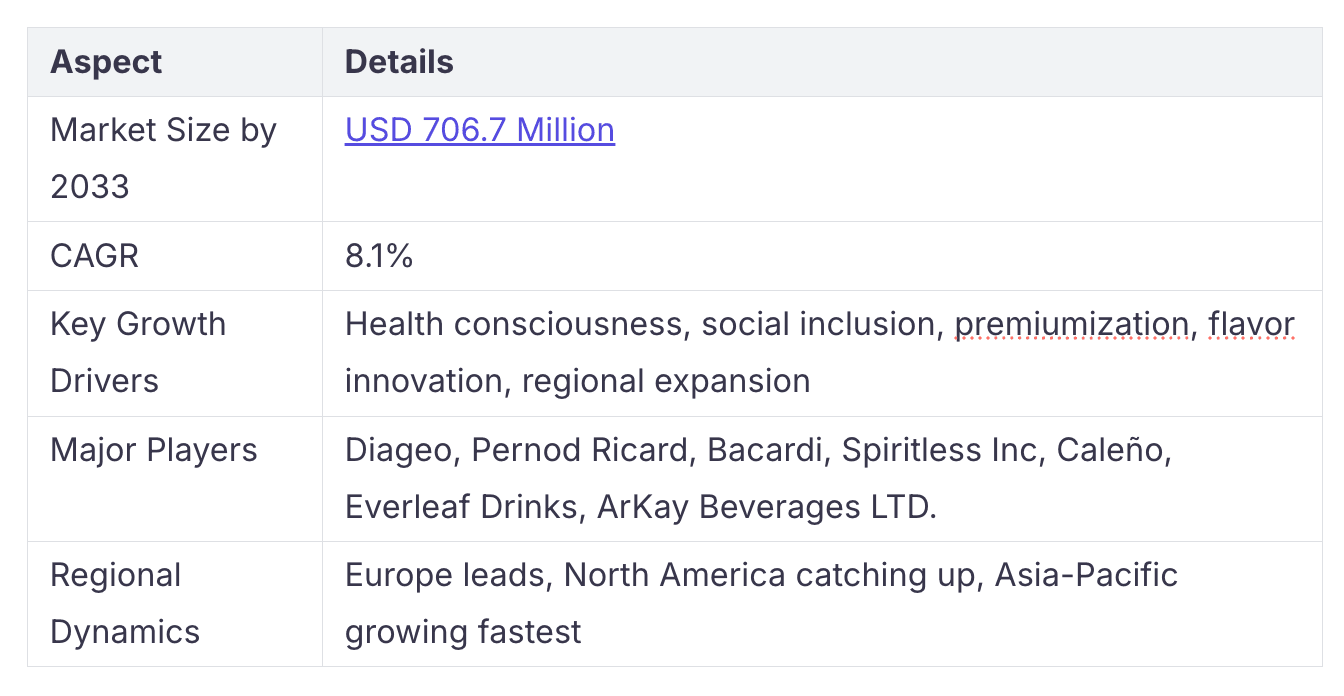
You notice more premium and craft non-alcoholic spirits on shelves. Brands focus on unique flavors, luxury packaging, and even collectible bottles. Bars and restaurants play a big role, letting you try new drinks in a social setting. Online stores also make it easy to find and buy these products. Younger people, especially Millennials and Gen Z, drive demand for new flavors and healthier options.
Tip: Many brands now offer tropical, spiced, or fruit-forward versions to attract adventurous drinkers.
Brand Response
Brands move quickly to meet your changing tastes. Big names like Diageo and Pernod Ricard launch new non-alcoholic spirits, while smaller companies create bold flavors and stylish packaging. You see more options in stores, bars, and even online. Some brands use digital tools, like apps, to help you track your alcohol intake and stay healthy.
-
Established brands expand their non-alcoholic lines to reach more shoppers and fit more occasions.
-
New brands, like Athletic Brewing, use social media and digital marketing to connect with you and other health-focused consumers.
-
You find non-alcoholic drinks at weddings, restaurants, and even in single-serve bottles for convenience.
-
Brands highlight how these drinks let you join social events without worrying about alcohol.
You notice that whisky brands now treat non-alcoholic options as part of their main lineup, not just a side project. This shift shows that the market is here to stay and will likely keep growing as more people look for balance and new experiences.
Challenges
Authenticity
You might wonder if non-alcohol whisky can ever feel as real as the original. Many people see these drinks as less authentic. They expect the same rich flavors and deep stories that come with traditional spirits. When you try a non-alcohol version, you may notice the taste is close but not quite the same. Some say it lacks the warmth or complexity they love.
Brands face a tough job. They need to create drinks that taste great and feel special. Many companies work with flavor experts and use new techniques to get closer to the real thing. They also focus on telling their story. When you hear about the care and creativity behind a bottle, you might feel more connected to it.
Note: People want to know how their drink is made. Clear information about ingredients and methods helps build trust.
A recent industry report points out that brands must innovate and work with experts to improve quality. They also need to share their journey online. When you see behind the scenes, you start to believe in the product.
Acceptance
Getting everyone on board is another big challenge. Some people still think non-alcohol options are only for those who cannot drink. Others believe these drinks are just a passing trend. You might hear friends question if they belong at a party or special event.
To change minds, brands use creative marketing and bold flavors. They invite you to try new drinks at bars and restaurants. They also use social media to show how these drinks fit into modern life.
A market analysis shows that people want more than just a substitute. They look for real flavor, honest stories, and a sense of belonging. When brands focus on these things, you feel more open to giving non-alcohol options a chance.
Tip: Next time you see a non-alcohol spirit on the menu, try it with an open mind. You might be surprised by how much you enjoy the experience.
The Future
Mainstream or Niche?
You might wonder if non-alcohol whisky will ever become as common as regular spirits. Right now, you see more bars, restaurants, and stores offering these options. The market keeps growing, and experts say this trend will not slow down soon. Many people, especially Millennials, drive this growth. They look for new flavors, care about health, and want to try premium products. Their interest could last for decades, making non-alcohol whisky a regular part of your choices.
Here’s what shapes the future:
-
The no-alcohol beverage category stands out in the global market, even when times get tough.
-
Millennials show strong loyalty to brands that meet their needs. Their youth means they could stick with non-alcohol whisky for years.
-
Many Millennials have higher incomes. They are willing to pay more for quality and unique experiences.
-
Companies keep launching new products and flavors to keep you interested.
You see more people switching from both regular alcohol and other non-alcoholic drinks. A recent study across countries like the US, UK, and Japan found that almost half of no/low alcohol drinkers used to choose other non-alcoholic drinks, while nearly a third switched from full-strength alcohol. This shows a real shift in how people think about drinking. You might notice friends who once loved cocktails now reach for non-alcohol options at parties or dinners.
Note: Big brands and new companies both invest in non-alcohol spirits. They see long-term growth, not just a passing trend.
Check out this table for a quick look at what’s driving the future:
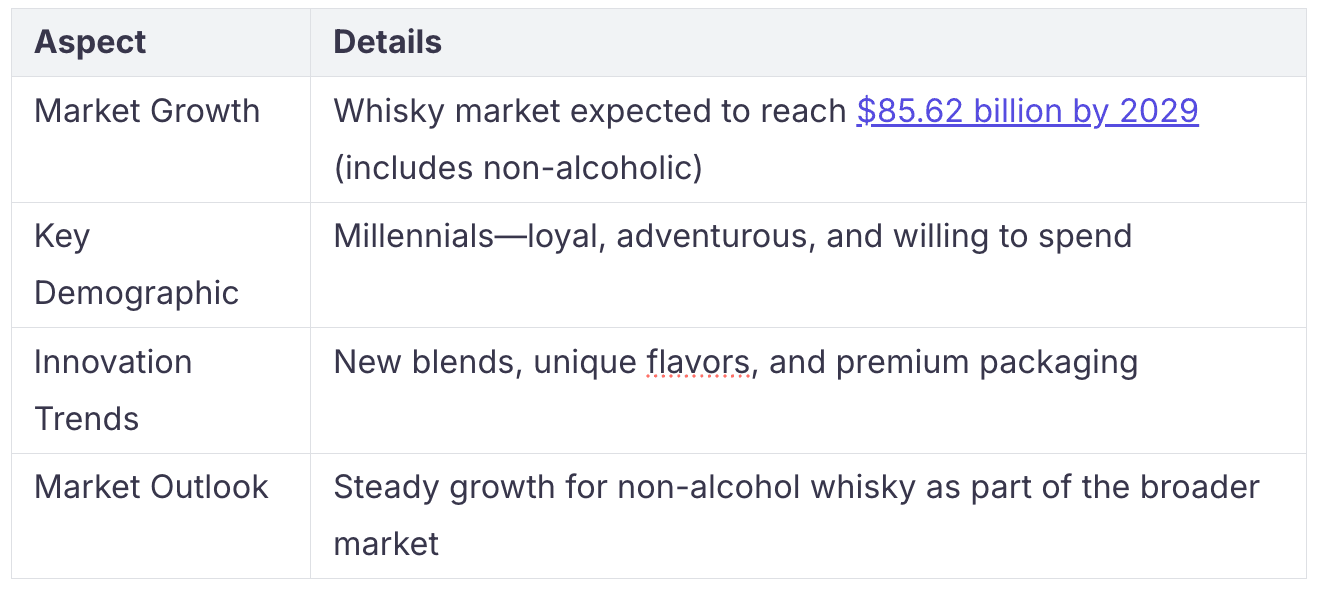
You can expect non-alcohol whisky to move from a niche product to a mainstream choice. As more people look for balance and new experiences, you will see these bottles on more shelves and menus.
Impact on Whisky
You might ask how non-alcohol whisky changes the world of whisky as a whole. The answer is bigger than you think. Traditional whisky will always have its fans, but non-alcohol options open the door for new drinkers. You can join tastings, enjoy the ritual, and share moments with friends, even if you skip the alcohol.
Here’s how the impact plays out:
-
More people feel included at social events. You don’t have to drink alcohol to join the fun.
-
Bars and restaurants create new cocktails and tasting menus. You get more choices and flavors.
-
Brands invest in both regular and non-alcohol whisky, making the whole category stronger.
-
The market grows as companies reach new customers and explore new ideas.
You see companies using digital marketing, e-commerce, and even sustainable ingredients to attract you. They launch limited editions and collectible bottles, making non-alcohol whisky exciting for both new and longtime fans. Distilleries expand and try new blends, sometimes mixing in regional flavors or health-focused ingredients.
Tip: If you love tradition, you can still enjoy classic whisky. If you want something new, non-alcohol whisky gives you a fresh way to join the culture.
The future looks bright for both types. You get more choices, better flavors, and a whisky culture that welcomes everyone. Whether you stick with the classics or try something new, you help shape what comes next.
You’ve seen how non-alcohol whisky is more than just a passing trend. The market keeps growing, and you notice new flavors and brands popping up everywhere. Here’s what stands out:
-
Younger generations drive demand and shape the future of whisky.
-
Big brands and craft makers keep launching creative no-alcohol options.
-
Global markets, even those with strict alcohol rules, now offer more choices.
You get to decide if you’ll join this shift or stick with tradition. Either way, whisky culture is changing, and your generation is a part of the story.
FAQ
What does non-alcohol whisky taste like?
You get flavors like caramel, vanilla, and oak. The taste feels lighter than regular whisky. You might notice less warmth and a quicker finish. Some brands add smoky or spicy notes. Each bottle offers a unique experience.
Can you use non-alcohol whisky in cocktails?
Yes! You can mix non-alcohol whisky into classic cocktails like an Old Fashioned or a Whisky Sour. It works well in mocktails, too. Try it with ginger ale or soda for a simple, tasty drink.
Is non-alcohol whisky safe for everyone?
Most people can enjoy non-alcohol whisky. It contains less than 0.5% alcohol by volume. If you have allergies or health concerns, check the label. Some brands use botanicals or sweeteners.
Tip: Always ask your doctor if you have special health needs.
How should you serve non-alcohol whisky?
You can pour it neat, over ice, or in a cocktail. Use a whisky glass to enjoy the aroma. Some people like it chilled. Try different ways to find what you like best.
About the author

Majda Hübner
My journey with whisky truly began when I joined Spiritory in 2024. What started as a job quickly grew into a deep appreciation for the stories behind each bottle. From elegant Highland single malts to bold American rye, every expression has its own unique charm. Through the blog, I share discoveries, insights, and favorites hoping to inspire both newcomers and fellow enthusiasts alike. If you love whisky or are just starting to explore it, welcome - you’re in good blog.
